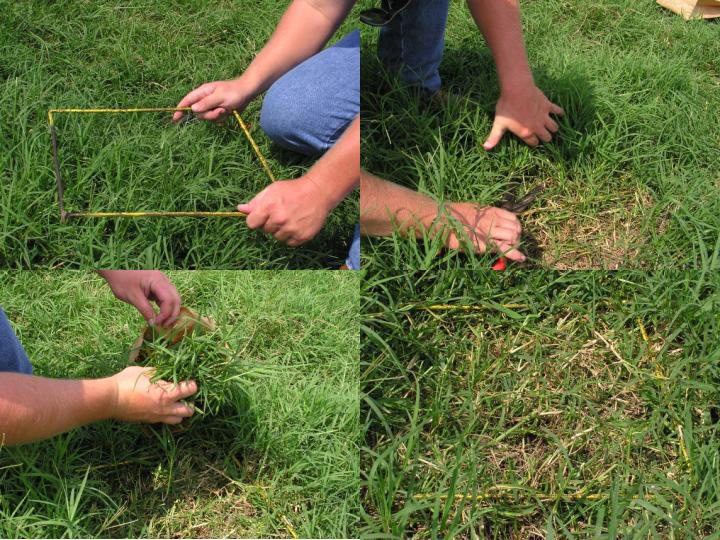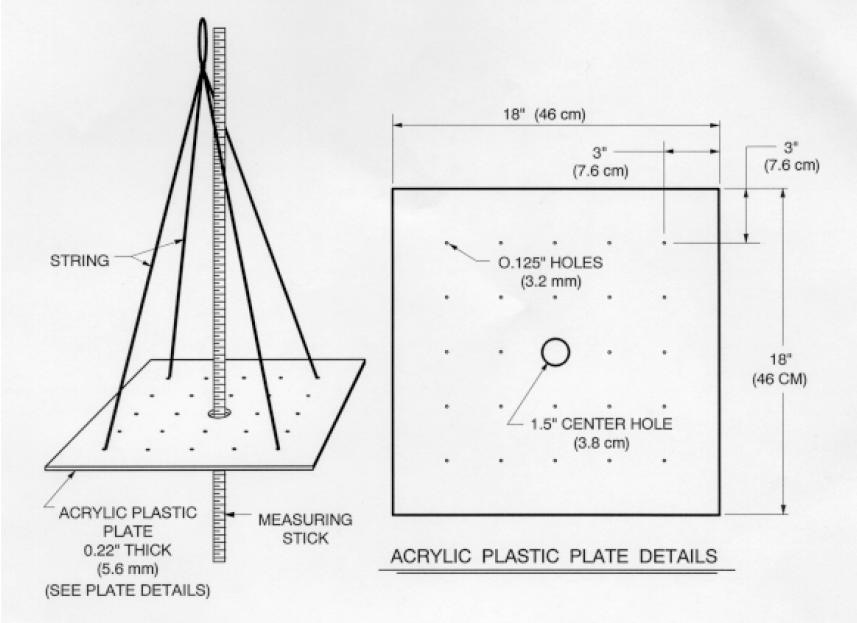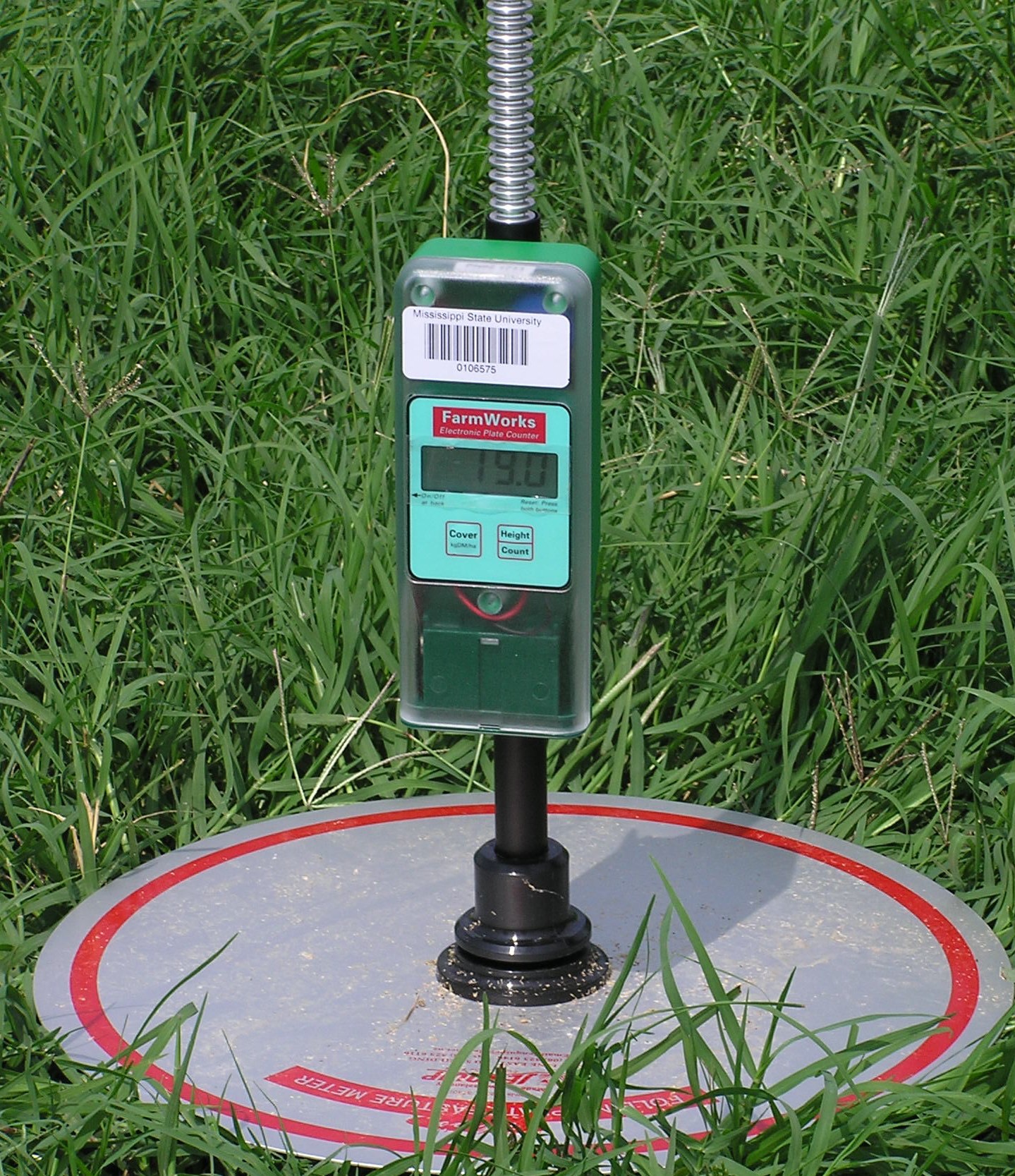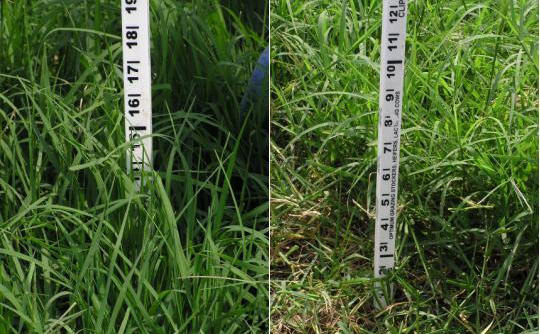Assessing Needs and Feed Sources: How Much Forage Do I Have?
Why Measure Yield?
Pasture yield is the most important influence on animal performance but is the most difficult to define and measure. Many of the decisions a livestock producer makes are related to the management of the available forage resources. Knowing the forage dry matter yield of your acreage is important when you make decisions about crop productivity, purchasing or selling hay, fertility and feeding, grazing schemes, and stocking rates. Remember that the amount of forage produced per acre will vary significantly from one location to another. These variations are due to climate changes, soil types, forage species, moisture, and management.
Ways to Measure Yield
Pasture managers are always looking for ways to extend the grazing season to improve livestock production. You need accurate estimates of forage availability to make decisions about carrying capacity, grazing intensity, and frequency. There are several methods to determine available forage. Clipping and weighing the forage in a given area is the most accurate method but requires you to dry and weigh clipped forage. Therefore, this method is time consuming. You can also use a falling plate meter. The falling plate meter measures the height of forage while it is depressed with a weighted plate. It takes density into account and is therefore more accurate than measuring the height. Measuring the height of existing forage using calibrated rulers is usually an easy method but is less reliable because it does not take stand density into account.
Clipping, Weighing, and Drying Method
This method is more accurate because you are measuring the dry matter in the pasture. Cut the forage from a measured area (1 or 2 square feet) about 2 to 3 inches into the soil surface depending on forage species (Figure 1). It is important to collect forage from several areas in the pasture to account for variation in vegetation. If the pasture is very uniform, three to four samples might be appropriate. In pastures with high variability in vegetation, it would be best to take eight to ten samples. Place each sample into a paper bag, weigh it, and dry it. You can dry the sample in the paper bag in a 100-120 °F oven for one day or more. However, oven drying is time- and energy-consuming; microwave drying is recommended. (See next page for details.) The dry weight will be used to determine the amount of forage dry matter per acre.

but it is time consuming.
Determining Forage Dry Matter Using a Microwave Oven
Weigh approximately 50 to 100 grams of chopped forage onto a microwave-safe dish or container. Heat the sample for two minutes at full power. Reweigh it.
If forage does not feel completely dry, reheat it for 30 seconds. Reweigh it. Continue drying and weighing until back-to-back weights are constant. Be careful not to heat the forage to the point where it chars. If charring occurs, use the previous weight. Caution: Microwaves vary considerably in drying capacity. It is better to dry for short intervals and reweigh until the last two weights are constant than to risk burning the forage and damaging the microwave.
To calculate the moisture percentage, subtract the last dry weight from the original wet weight and divide this number by the wet weight. Now multiply by 100. This is the moisture content of the sample.
moisture percentage =
[(wet weight - dry weight) ÷ wet weight] x 100
Example:
Original wet weight was 100 grams.
Dry weight is 60 grams.
100 - 60 = 40
(40 ÷ 100) x 100 =
40% moisture and 60% dry matter (DM)
To determine the amount of forage based on dry matter percentage, you need to know the size of the collection area (1 or 2 ft2) and the total weight (in grams) of the sample collected in the square. Remember that a subsample will be used for determining the dry matter percentage.
Available Forage (lb/ac) =
% DM x area x total sample weight (grams)
Available forage using 1 ft2:
Forage (lb/ac) =
% DM x (43,560/ac) x (total sample weight x 0.0022)
Available forage using 2 ft2:
Forage (lb/ac) =
% DM x (21,780/ac) x (total sample weight x 0.0022)
Example:
A forage sample was collected in a 1-foot square. The weight of the sample was 200 grams. Fifty grams of the sample were dried. The dry weight was 32 grams. What is the amount of forage available?
First, calculate your moisture percentage:
[(50 – 32) ÷ 50] x100 = 36% moisture.
The percentage of dry matter is 64% (100%-36%).
Forage (lb/ac) =
0.64 x 43560 x (200 x 0.0022) =
12266.2 lb/ac or 6 tons/ac
Rapid Pasture Mass Estimates
Producers need rapid methods for pasture mass estimation. These methods are less accurate but far more convenient.
Falling Plate Meter
There are different types of plate meters available for purchase, but you can make a falling plate meter from materials that are easy to find. Plate meters are generally made of a yardstick and sheet metal, plexiglass, or acrylic plastic. Some modifications have been made to the basic design to establish the effect of size and area weight on the performance of these meters.
The falling plate in the figure below is made from 0.22-inch thick acrylic plastic cut into an 18-inch square. A 1.5-inch hole is cut in the center of the plate. A yardstick is used for measuring the plate’s height above the ground when it is set on the turf. In addition, 24 holes with 0.125-inch diameters are drilled along five lines set at 3-inch intervals. Always start 3 inches from the plate’s edge. Each hole is also spaced at 3-inch intervals along these lines. The yardstick is connected to the plate using string attached to the holes in the corners of the plate (Figure 2).


To measure forage availability, select random locations in the pasture where there is enough forage to support the plate. Measure the height of the plate’s top above the ground (Figure 3). Make sure that the plate is dropped from the same height each time to reduce variability caused by the speed of the plate as it falls. Record the height of the pasture plate on the yardstick. It is important to measure several locations within the pasture (at least 30) and obtain an average to get a good estimate of forage mass in the pasture. It is important that the same person collect all the data to avoid large variability. The following formula could be used to estimate dry matter yield (DMY) from pasture plate (Cosgrove and Undersander, 2001):
DMY (lb/ac) = 390 x Plate Height (in)
|
Forage Species |
Yield (lb/ac/in) |
|---|---|
|
Alfalfa |
225 |
|
Annual Legumes |
130 |
|
Arrowleaf Clover |
200 |
|
Crimson Clover |
200 |
|
Red Clover |
220 |
|
Sericea Lespedeza |
175 |
|
Forage Species |
Yield (lb/ac/in) |
|---|---|
|
Annual Ryegrass: Fall Drill |
250 |
|
Annual Ryegrass: Fall Broadcast |
170 |
|
Annual Ryegrass: Spring Broadcast |
200 |
|
Orchardgrass |
180 |
|
Orchardgrass: clover |
200 |
|
Tall Fescue |
210 |
|
Small Grains*: Fall Drilled |
150 |
|
Small Grains: Spring Drilled |
115 |
|
Forage Species |
Yield (lb/ac/in) |
|---|---|
|
Bahiagrass |
285 |
|
Bermudagrass |
260 |
|
Crabgrass |
130 |
|
Dallisgrass |
150 |
|
Native Warm Season Grasses |
200 |
|
Mixed Pasture |
180 |
*Small grains = rye, oats, wheat, barley, and triticale
Sources: Noble Foundation Grazing School, 2007 (online);
Ball et al., 2002

|
Livestock |
DDMI (lb) |
|---|---|
|
Beef yearling steers – medium frame |
21.6 |
|
Beef yearling steers – large frame |
25.2 |
|
Beef yearling heifers – medium frame |
21.6 |
|
Beef yearling heifers – large frame |
25.2 |
|
Beef 2 yr heifers 800-1000 lb; mod milk |
24.2 |
|
Beef 2 yr heifers 1000-1200 lb; mod milk |
28.1 |
|
Beef 2 yr heifers 800-1000 lb; high milk |
29.6 |
|
Beef 2 yr heifers 1000-1200 lb; high milk |
32.8 |
|
Beef cows 900-1000 lb; moderate milk |
26.0 |
|
Beef cows 1100-1300 lb; moderate milk |
28.6 |
|
Beef cows 1300-1500 lb; moderate milk |
31.0 |
|
Beef cows 900-1000 lb; high milk |
28.6 |
|
Beef cows 1100-1300 lb; high milk |
31.7 |
|
Beef cows 1300-1500 lb; high milk |
34.8 |
|
Beef bulls |
39.0 |
|
Dairy cows 1000 lb; 50% forage ration |
20.0 |
|
Dairy cows 1300 lb; 50% forage ration |
26.0 |
|
Dairy cows 1600 lb; 50% forage ration |
32.0 |
|
Livestock |
DDMI (lb) |
|---|---|
|
Horses – mature maintenance |
24.3 |
|
Horses – mares mid-gestation |
24.3 |
|
Horses – mares late-gestation |
27.0 |
|
Horses – mares 1st 3 mo. lactation |
32.4 |
|
Horses – mares late-lactation |
29.7 |
|
Horses – weanlings 4-6 mo. |
13.5 |
|
Horses – weanlings 6-12 mo. |
18.9 |
|
Horses – Yearlings 12-18 mo |
21.6 |
|
Horses – 18-24 mo. |
24.3 |
|
Horses – Light work |
27.0 |
|
Horses – Moderate work |
29.7 |
|
Horses – Heavy work |
32.4 |
|
Horses – Stallions |
29. |
|
Livestock |
DDMI (lb) |
|---|---|
|
Mature sheep – 150 lb |
3.0 |
|
Ewes – winter lamb – 175 lb |
5.5 |
|
Ewes – May lamb – 175 lb (140% lamp crop) |
6.2 |
|
Ewes – May lamb – 175 lb (180% lamp crop) |
6.8 |
|
Replacement ewe lambs – 80 lb |
3.4 |
|
Replacement ewe lambs – 100 lb |
4.4 |
|
Replacement ewe lambs – 120 lb |
4.4 |
|
Mature Rams |
4.0 |
|
Livestock |
DDMI (lb) |
|---|---|
|
Mature doe with kids |
5.9 |
|
Weaned kid to yearling |
10.0 |
|
Mature buck |
4.5 |
|
Donkey – 700 lb |
21.0 |
Sources: Holechek et al., 2004; Banhart, 1998; and Sedivec, 1996.
Plant Height
Most producers do a visual evaluation and assume that the taller the pasture, the greater the yield. However, that is not always the case; plant density also plays a major role in forage availability. Pasture height can be used to get a rough estimate of forage availability. It is commonly assumed that there is 200 lbs of dry matter yield per acre of inch of forage height. This rough estimate can vary approximately 50 lb/ac/in depending on the forage species and seasonality. Table 1 gives an indication of some forage species’ productivity depending on stand condition.
To allow a rapid recovery and reduce stand loss, do not graze pasture below 3 inches. This means that if a pasture has 6 inches of growth, 3 inches are grazeable. Assuming 200 pounds (dry matter) of grass per acre-inch, a pasture of 50 acres would give 30,000 pounds of total available forage (50 acres times 3 inches times 200 lbs/acre/inch). It is safe to assume that harvest efficiency under continuous grazing is approximately 25 to 50%, but efficiency can increase up to 75% in a rotational grazing system. Thus, the livestock will consume only 15,000 pounds of forage. You can find an estimate of the amount of dry matter different types of livestock eat per day on Table 2. Dairy cows require about 26 pounds of forage (dry matter) per day. Fifty cows eating 26 pounds of dry matter per day equals 1,300 pounds of total forage consumed daily. The 15,000 pounds of forage available on the 50 acre pasture above would be consumed by 50 cows in about 12 days (15,000 lbs. available in pasture / 1,300 lb. daily consumption by herd). An ideal management goal is 50%: take half and leave half.
The formula below calculates the approximate number of days that the pasture can support a specific group of animals:
Days =
[total forage (lbs/ac) x # acres x % grazing efficiency] ÷ [avg. animal wt. x intake rate (% body weight) x # animals]
References
Ball, D.M., C.S. Hoveland, and G.D. Lacefield. 2002. Southern Forages (3rd ed). Lawrenceville, GA: Graphic Communications Corp.
Banhart, S.K. 1998. Guide for year-round forage supply. Iowa State Univ. Coop. Ext. Service. PM 1771.
Cosgrove, D. and D. Undersander. 2001. Evaluation of a simple method for measuring pasture yield. Univ. of Wisconsin Coop. Ext. Serv.
Grazing Stick Instruction Manual. 2007. The Samuel Roberts Nobel Foundation. https://www.nrcs.usda.gov/wps/portal/nrcs/ia/technical/landuse/pasture/how+to+use+a+grazing+stick/
Holechek, J.L., R.D. Pieper, and C.H. Herbel. 2004. Range Management: Principles and Practices. Upper Saddle River, NJ: Pearson Prentice Hall.
Rayburn, E. and J. Lozier. 2003. A falling plate meter for estimating forage mass. West Virginia Univ. Coop. Ext. Serv.
Sedivec, K. 1996. Determining pasture rental rates. North Dakota State Univ. Coop. Ext. Serv. R-1092. http://www.ag.ndsu.edu/pubs/plantsci/hay/r1092w.htm.
Publication 2458 (POD-02-20)
By Rocky Lemus, PhD, Extension/Research Professor, Plant and Soil Sciences, Jane Parish, Professor and Head, North Mississippi Research and Extension Center, and Jimmy Ray Parish, former Forage Variety Manager, Department of Plant and Soil Sciences.
Copyright 2020 by Mississippi State University. All rights reserved. This publication may be copied and distributed without alteration for nonprofit educational purposes provided that credit is given to the Mississippi State University Extension Service.
Produced by Agricultural Communications.
Mississippi State University is an equal opportunity institution. Discrimination in university employment, programs, or activities based on race, color, ethnicity, sex, pregnancy, religion, national origin, disability, age, sexual orientation, genetic information, status as a U.S. veteran, or any other status protected by applicable law is prohibited. Questions about equal opportunity programs or compliance should be directed to the Office of Compliance and Integrity, 56 Morgan Avenue, P.O. 6044, Mississippi State, MS 39762, (662) 325-5839.
Extension Service of Mississippi State University, cooperating with U.S. Department of Agriculture. Published in furtherance of Acts of Congress, May 8 and June 30, 1914. GARY B. JACKSON, Director
The Mississippi State University Extension Service is working to ensure all web content is accessible to all users. If you need assistance accessing any of our content, please email the webteam or call 662-325-2262.




